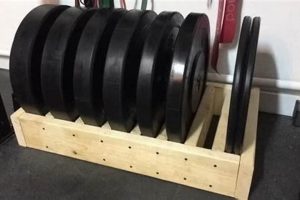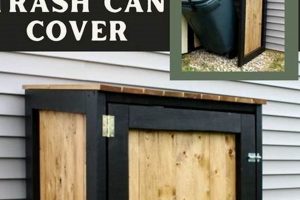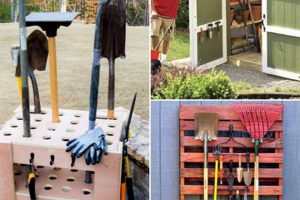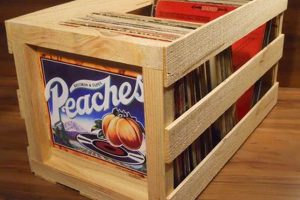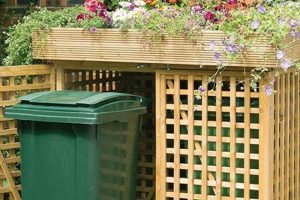Effective organization of plush toys can be achieved through inventive, self-initiated projects. These projects address the common issue of accumulating a large collection of soft playthings and the subsequent need for an efficient and aesthetically pleasing method of containment. An example includes constructing a hanging net from repurposed materials to house the items in an elevated corner, thereby maximizing floor space.
Implementing custom-built systems offers numerous advantages. These range from decluttering living spaces and creating a more organized environment to potentially reducing dust accumulation on the toys themselves. Historically, solutions for managing these collections have evolved from simple containers to more elaborate, integrated elements of interior design.
The following sections will explore specific strategies for constructing and implementing various storage solutions, including considerations for space utilization, material selection, and aesthetic integration within the home.
Effective Strategies for Plush Toy Management
The following outlines practical methods for creating customized organizational solutions for collections of soft toys. These tips focus on optimizing space and maintaining a visually appealing environment.
Tip 1: Maximize Vertical Space. Employ wall-mounted shelving units to elevate collections. This approach keeps items off the floor and utilizes otherwise unused space. Consider adjustable shelving to accommodate varying sizes.
Tip 2: Utilize Repurposed Furniture. Existing bookcases, cabinets, or drawers can be adapted. Refinishing or modifying these pieces to fit a specific aesthetic can integrate the solution seamlessly into the room’s design.
Tip 3: Implement Hanging Storage. Fabric nets or macrame hangers suspended from the ceiling offer an alternative for lightweight items. Ensure secure mounting to support the weight of the collection.
Tip 4: Consider Under-Bed Containers. Shallow bins designed for placement beneath beds are suitable for storing a significant number of items while remaining discreet. Choose transparent containers for easy identification of contents.
Tip 5: Create a Dedicated Display Area. A designated corner or section of a room can be transformed into a visually appealing showcase. Utilize tiered stands or custom-built platforms to elevate certain items.
Tip 6: Explore Toy Hammocks. Corner-mounted hammocks provide a convenient and accessible solution for storing numerous lightweight toys. Installation requires secure wall anchors and durable construction.
Tip 7: Utilize Storage Ottomans. These dual-purpose furniture pieces offer seating while concealing interior storage space. Select ottomans with ample capacity and durable construction to withstand regular use.
By implementing these strategies, one can achieve a well-organized and visually appealing solution for the challenge of managing a significant number of plush toys.
The subsequent section will address specific material choices and construction techniques for implementing the aforementioned strategies.
1. Space Optimization
Space optimization, in the context of self-initiated soft toy containment, refers to the efficient and effective utilization of available physical volume to accommodate a collection of plush toys while minimizing clutter and maximizing usability of the surrounding environment. It is a critical element of successful implementation, influencing functionality and overall aesthetic appeal.
- Vertical Space Exploitation
The utilization of vertical space, often underutilized in residential environments, becomes paramount. Implementing shelving systems, hanging organizers, or tiered displays transforms unused wall areas into functional zones for toy storage. This approach minimizes the floor footprint occupied by the collection, freeing up valuable space for other activities. For instance, corner shelves extending from floor to ceiling can house a substantial number of toys while occupying minimal floor area.
- Multi-Purpose Furniture Integration
The selection of furniture serving dual roles optimizes space by combining storage with functionality. Examples include storage ottomans, benches with built-in compartments, or beds with under-bed storage drawers. This strategy eliminates the need for dedicated storage units, thereby reducing the overall furniture footprint within a room. An ottoman that doubles as a toy repository allows for both seating and concealment of the collection.
- Strategic Placement Considerations
Careful consideration of location is essential. Selecting areas that are typically underutilized, such as corners, spaces under staircases, or the area above doorways, maximizes space efficiency. A custom-built shelf above a doorway, for example, can provide ample storage without impeding access or diminishing the usability of the room. The strategic assessment of spatial opportunities minimizes the impact on the room’s primary function.
- Adaptable Storage Solutions
Selecting modular or adaptable storage systems allows for adjustments as the collection grows or shrinks. Units that can be reconfigured or expanded provide long-term flexibility and prevent the need for complete replacement as storage needs evolve. An expandable shelving unit, for instance, can accommodate increasing numbers of plush toys without requiring a completely new storage solution.
These facets of space optimization directly contribute to a more organized and functional living environment. By carefully considering the available space and implementing these strategies, individuals can effectively manage their plush toy collections without compromising the overall usability and aesthetic appeal of their homes. The degree to which space is optimized directly impacts the success and sustainability of plush toy management.
2. Material Selection
Material selection plays a crucial role in the effectiveness and longevity of self-initiated plush toy containment projects. The choice of materials directly impacts structural integrity, aesthetic integration, and overall cost-effectiveness. Inadequate material selection can result in structural failure, detract from the room’s visual appeal, and necessitate frequent replacements, thereby undermining the intended benefits. For example, using flimsy fabric for a hanging storage net may lead to tearing under the weight of the toys, while selecting non-toxic paint for wooden shelving ensures safety, particularly in children’s rooms.
Considerations extend beyond mere structural soundness. The chosen materials should align with the room’s existing decor and the intended aesthetic. Employing natural fibers such as cotton or linen for visible storage solutions creates a softer, more organic feel, whereas utilizing durable plastics or metal framing ensures resilience and ease of cleaning in high-traffic areas. The selection must balance functionality with visual appeal. Furthermore, repurposing existing materials, such as old crates or fabric scraps, aligns with sustainable practices and reduces project costs. This approach can transform discarded items into functional and aesthetically pleasing components of the storage solution.
Ultimately, the successful implementation of self-initiated plush toy containment relies heavily on informed material selection. Careful consideration of factors such as durability, safety, aesthetics, and cost-effectiveness ensures a functional and visually appealing storage solution. Overlooking the importance of material selection can lead to structural failures, increased costs, and diminished aesthetic appeal, thereby negating the benefits of a customized organizational approach. The inherent value of material choices are thus intricately linked to the project’s overall success.
3. Accessibility
Accessibility, within the context of self-created soft toy containment, pertains to the ease with which toys can be retrieved or stored. An effective solution prioritizes usability, allowing children to independently manage their collections and promoting a sense of ownership and responsibility. Conversely, solutions that necessitate adult assistance or complex maneuvering diminish their practical value, potentially leading to disuse and a return to disorganized conditions. For example, a low-hanging net allows a child to easily reach and retrieve a desired toy, whereas a high shelf requires adult intervention and diminishes the child’s agency.
The design and placement of storage units significantly influence accessibility. Open bins or baskets placed at floor level offer unrestricted access, enabling children to quickly select and return toys. Clear labeling or transparent containers further enhance usability by facilitating visual identification of contents. In contrast, lidded containers or tightly packed shelves can impede access, making it difficult to locate specific items. The physical dimensions of the storage unit and the user’s physical capabilities must also be considered. A solution that is too deep or too high may be impractical for younger children, while a system with inadequate weight capacity may pose a safety hazard.
Optimizing accessibility in self-initiated plush toy management requires a user-centered approach. The design should prioritize ease of use and independent access, empowering children to manage their collections and fostering a sense of order and responsibility. Neglecting accessibility can undermine the effectiveness of the storage solution, leading to frustration and disuse. Ultimately, a well-designed and accessible system promotes both organization and independence, contributing to a more functional and enjoyable living environment.
4. Aesthetic Integration
Aesthetic integration represents a critical consideration within self-directed soft toy containment projects. It refers to the seamless incorporation of storage solutions into the existing visual environment, ensuring that the organizational system enhances, rather than detracts from, the room’s overall design. Proper aesthetic integration transforms functional storage into a cohesive element of the interior space.
- Color Palette Harmonization
Synchronization of color schemes between the storage solution and the surrounding decor is essential. Selection of colors that complement or subtly contrast the room’s existing palette contributes to a unified and visually appealing environment. For instance, painting wooden shelves the same shade as the wall color creates a seamless and integrated look, while using complementary colors can provide a subtle accent without disrupting the overall harmony.
- Material Consistency
Employing materials that align with the existing textures and materials within the room ensures a cohesive aesthetic. Utilizing natural wood tones in a room with existing wooden furniture, or incorporating metallic accents that echo the hardware, creates a sense of visual continuity. Inconsistent material choices can disrupt the overall visual flow and create a discordant appearance.
- Style Compatibility
Adherence to a consistent design style is paramount. Storage solutions should complement the existing architectural and decorative style of the room. A modern minimalist space calls for sleek, uncluttered storage, whereas a rustic or bohemian room may benefit from repurposed or handcrafted storage solutions. Divergence from the prevailing style can create a sense of incongruity.
- Scale and Proportion Consideration
The size and proportion of the storage unit must be carefully considered in relation to the room’s dimensions and other furnishings. Overly large or bulky storage can overwhelm a small space, while undersized solutions may appear inadequate or insignificant. Maintaining appropriate scale and proportion contributes to a balanced and visually harmonious environment.
These facets of aesthetic integration are integral to the success of plush toy storage projects. By thoughtfully considering color, material, style, and scale, one can create a storage solution that not only effectively contains soft toys but also enhances the overall visual appeal of the room. Aesthetic integration transforms storage from a purely functional element into a cohesive and visually pleasing aspect of the interior design.
5. Structural Integrity
Structural integrity, in the context of self-initiated plush toy containment systems, refers to the ability of the storage solution to withstand applied loads and maintain its intended form and function over time. Its importance cannot be overstated, as a failure in structural integrity can lead to collapse, injury, or damage to both the toy collection and surrounding environment.
- Material Load Capacity
The load-bearing capacity of the selected materials is paramount. For example, a shelf constructed from thin particleboard may buckle under the weight of a substantial collection of stuffed animals, whereas a solid wood shelf of sufficient thickness will provide adequate support. The material must be capable of withstanding the anticipated weight without deformation or failure. The specific weight of the toys to be stored must be carefully calculated and compared to the load capacity of the materials chosen.
- Joint Strength and Stability
The strength and stability of joints within the storage structure are critical. Weak or poorly constructed joints can compromise the overall integrity of the system. For example, joints secured only with small finishing nails may fail under stress, whereas joints reinforced with screws, glue, or interlocking joinery techniques provide greater stability. The chosen method of joining materials must be appropriate for the applied loads and the properties of the materials themselves.
- Mounting and Anchoring Security
For wall-mounted solutions, the security of mounting and anchoring is essential. Inadequate anchoring can result in the storage unit detaching from the wall, posing a significant safety hazard. The appropriate type of anchors must be selected based on the wall construction (e.g., drywall, plaster, concrete) and the weight of the storage unit and its contents. Overlooking the anchoring solution is never an option.
- Long-Term Durability Considerations
Long-term durability and resistance to wear and tear must be considered. Materials susceptible to moisture, rot, or insect infestation may degrade over time, compromising the structural integrity of the storage solution. The selected materials should be resistant to these factors or treated accordingly to ensure longevity and sustained performance. For example, using treated lumber in damp environments can prevent rot and extend the lifespan of the structure. The longevity of materials are therefore important considerations.
These interconnected facets of structural integrity are essential for the safe and effective implementation of plush toy storage systems. Careful consideration of material load capacity, joint strength, mounting security, and long-term durability ensures a stable and reliable storage solution, minimizing the risk of failure and protecting both the toys and the surrounding environment. Ignoring structural integrity is a risky proposition.
6. Cost-effectiveness
Cost-effectiveness represents a primary driver for many individuals choosing to implement self-directed plush toy containment solutions. The economic benefits derived from these projects, relative to purchasing commercially available storage systems, often justify the investment of time and effort. Evaluating cost-effectiveness requires a comprehensive analysis encompassing material expenses, labor value, and long-term savings.
- Material Sourcing and Repurposing
The strategic sourcing of materials and the repurposing of existing items significantly impact overall cost. Utilizing reclaimed wood, repurposed containers, or discounted fabric remnants reduces expenditure compared to purchasing new materials at retail prices. For instance, transforming old wooden crates into shelving units or repurposing fabric scraps into storage bins minimizes material costs. Strategic material selection is essential for achieving cost-effectiveness.
- Labor Investment and Value
The time and effort invested in constructing a storage solution represent a form of labor cost, albeit one not directly paid in monetary terms. While self-directed labor eliminates direct payment, it necessitates allocating time and resources that could otherwise be used for income-generating activities. Accurately assessing the value of this labor is crucial in determining the true cost-effectiveness of the project. A complex storage solution requiring extensive time and skill may ultimately prove less cost-effective than a simpler, quicker alternative.
- Longevity and Durability
The long-term durability and lifespan of the storage solution directly influence its cost-effectiveness. Constructing a robust and durable system from quality materials minimizes the need for frequent repairs or replacements, thereby reducing long-term expenditure. Investing in higher-quality materials and construction techniques upfront can yield significant savings over time, as opposed to constructing a cheaper, less durable system that requires frequent maintenance or replacement.
- Comparison with Commercial Alternatives
A thorough comparison of the total cost of a self-directed project with the price of commercially available storage options is essential for evaluating cost-effectiveness. Factors such as material costs, labor value, and long-term durability must be considered in relation to the price of comparable commercial products. A detailed cost-benefit analysis can reveal whether the self-directed approach offers a genuine economic advantage or whether purchasing a ready-made solution is ultimately more cost-effective. Considerations must be also for the long-term.
The interplay of these factors determines the overall cost-effectiveness of self-directed plush toy containment projects. Strategic material sourcing, realistic assessment of labor value, emphasis on durability, and a comprehensive comparison with commercial alternatives enable individuals to make informed decisions and maximize the economic benefits of their storage solutions. An effective approach to achieve the targeted cost saving is necessary for self-initiated project.
7. Durability
Durability constitutes a fundamental attribute in the realm of self-initiated plush toy containment solutions. Its significance stems from the inherent need for these systems to withstand prolonged use, repeated handling, and potential exposure to environmental stressors. The longevity and resilience of a storage solution directly influence its cost-effectiveness and overall practicality.
- Material Selection and Resistance to Wear
The choice of materials significantly dictates the durability of the final product. Robust materials such as solid wood, reinforced canvas, or durable plastics exhibit greater resistance to wear and tear than less resilient alternatives. For example, storage bins constructed from thin cardboard are prone to tearing and deformation, whereas bins made from durable polypropylene withstand repeated use and handling. Material composition dictates its resistance to the wear and tear.
- Construction Techniques and Joint Integrity
The manner in which a storage system is assembled profoundly impacts its structural integrity and long-term durability. Solid construction techniques, such as robust joinery, secure fastening methods, and reinforced seams, enhance the system’s ability to withstand stress and maintain its form over time. Poorly constructed joints or loosely fastened components compromise the system’s structural integrity and lead to premature failure. Construction techniques are essential for its longevity.
- Resistance to Environmental Factors
Environmental factors, such as moisture, sunlight, and temperature fluctuations, can degrade materials and diminish the durability of a storage solution. Materials resistant to moisture and UV radiation are essential for systems located in humid or sunny environments. For example, untreated wood exposed to moisture is susceptible to rot and decay, whereas treated or sealed wood offers greater resistance. The ability of storage unit resist degradation in environmental factors are very important.
- Maintenance and Repair Considerations
The ease with which a storage system can be maintained and repaired influences its long-term durability. Solutions that are easily cleaned, repaired, or refurbished offer a greater lifespan than those that are difficult or impossible to maintain. For example, a storage bin with a removable and washable liner can be easily cleaned, extending its lifespan, while a system constructed from permanently bonded components may be impossible to repair if damaged. Repairability prolong its lifespan.
The integration of durable materials, sound construction techniques, resistance to environmental stressors, and provisions for maintenance collectively determine the longevity and practicality of self-initiated plush toy containment systems. Prioritizing durability ensures a long-lasting and cost-effective solution that effectively manages toy collections while withstanding the rigors of daily use.
Frequently Asked Questions
This section addresses common inquiries regarding the design, construction, and implementation of self-directed storage solutions for plush toys. The information provided aims to clarify misconceptions and provide practical guidance.
Question 1: What constitutes an adequate weight-bearing capacity for shelving intended to store soft toys?
The required weight-bearing capacity depends on the size and density of the toy collection. It is recommended to overestimate the weight to account for future additions. As a general guideline, shelving should support a minimum of 20 pounds per linear foot. Consulting load-bearing charts for specific materials is advisable.
Question 2: Are there specific paint types that should be avoided when constructing storage solutions for children’s rooms?
Paints containing volatile organic compounds (VOCs) should be avoided. Opt for low- or zero-VOC paints to minimize potential health risks. Ensure the paint is also lead-free and specifically formulated for use on children’s furniture.
Question 3: How can one effectively prevent dust accumulation on toys stored in open containers?
Regular cleaning is essential. Periodically vacuuming the toys with a soft brush attachment or placing them in a clothes dryer on a no-heat cycle can remove dust. Additionally, covering open containers with lightweight fabric when not in use can minimize dust accumulation.
Question 4: What are the most suitable materials for constructing a hanging toy hammock?
Durable netting, strong rope, and secure mounting hardware are crucial. Heavy-duty nylon netting or tightly woven cotton canvas are suitable choices. Ensure the rope is rated for the intended weight and the mounting hardware is appropriate for the wall construction.
Question 5: How does one ensure the stability of a storage ottoman intended for use as both seating and toy storage?
Select an ottoman with a sturdy frame constructed from solid wood or reinforced metal. Ensure the hinges and lid supports are robust and capable of withstanding repeated opening and closing. Distribute weight evenly within the ottoman to prevent tipping.
Question 6: What are the key considerations when selecting under-bed storage containers for plush toys?
Choose containers that are low-profile and easily slide under the bed frame. Opt for transparent containers to allow for easy identification of contents. Ensure the containers are constructed from durable plastic that can withstand repeated sliding and prevent moisture accumulation.
In summary, the successful implementation of storage solutions for plush toys necessitates careful consideration of material selection, structural integrity, and safety. Adhering to these guidelines ensures a functional and aesthetically pleasing outcome.
The following section will provide a concise conclusion summarizing the main points discussed throughout this article.
DIY Stuffed Animal Storage
This exploration has underscored the multifaceted nature of creating self-directed containment solutions for plush toys. The efficacy of such projects hinges on a balanced consideration of space optimization, material selection, accessibility, aesthetic integration, structural integrity, cost-effectiveness, and durability. The successful implementation of storage solutions requires a comprehensive understanding of these interconnected factors, ensuring a functional, visually appealing, and sustainable outcome.
The information presented herein should serve as a framework for informed decision-making. Prioritizing careful planning, meticulous execution, and ongoing maintenance will maximize the benefits derived from self-initiated storage projects. The commitment to thoughtfully addressing the presented considerations ensures a more organized, aesthetically pleasing, and functional living environment.



